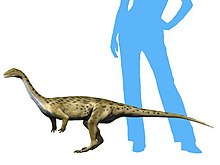Saturnalia (dinosaur)
|
Saturnalia Temporal range: Late Triassic, 228 Ma |
|
|---|---|
 |
|
| Life restoration | |
| Scientific classification | |
| Kingdom: | Animalia |
| Phylum: | Chordata |
| Class: | Reptilia |
| Clade: | Dinosauria |
| Order: | Saurischia |
| Suborder: | †Sauropodomorpha |
| Family: | †Guaibasauridae |
| Subfamily: | †Saturnaliinae |
| Genus: |
†Saturnalia Langer et al., 1999 |
| Species: | †S. tupiniquim |
| Binomial name | |
|
Saturnalia tupiniquim Langer et al., 1999 |
|
Saturnalia is an extinct genus of basal sauropodomorph dinosaur known from the Triassic of Rio Grande do Sul, southern Brazil.
Saturnalia was originally named on the basis of three partial skeletons. The holotype, MCP 3844-PV, a well-preserved semi-articulated postcranial skeleton, was discovered in mid-summer at Sanga da Alemoa, Rio Grande do Sul, in Brazil, in the geopark of Paleorrota. The two paratypes are MCP 3845-PV, partial skeleton including natural cast of partial mandible with teeth and some postcranial remains, and MCP 3846-PV, partial skeleton including postcranial remains. All specimen were collected in the "Wald-Sanga" (also known as "Sanga do Mato") locality from the Alemoa Member of the Santa Maria Formation (Rosário do Sul Group), dating to the Carnian faunal stage of the early Late Triassic, about 228 million years ago. A partial femur from the Carnian Pebbly Arkose Formation of Zimbabwe was also attributed to the genus. It is one of the oldest true dinosaurs yet found. It probably grew to about 1.5 meters (5 ft) long.
...
Wikipedia
